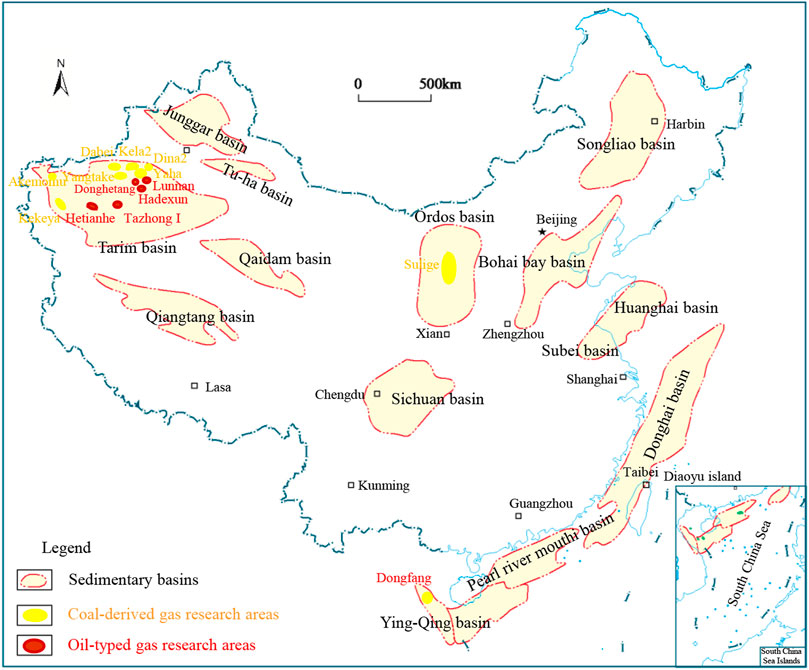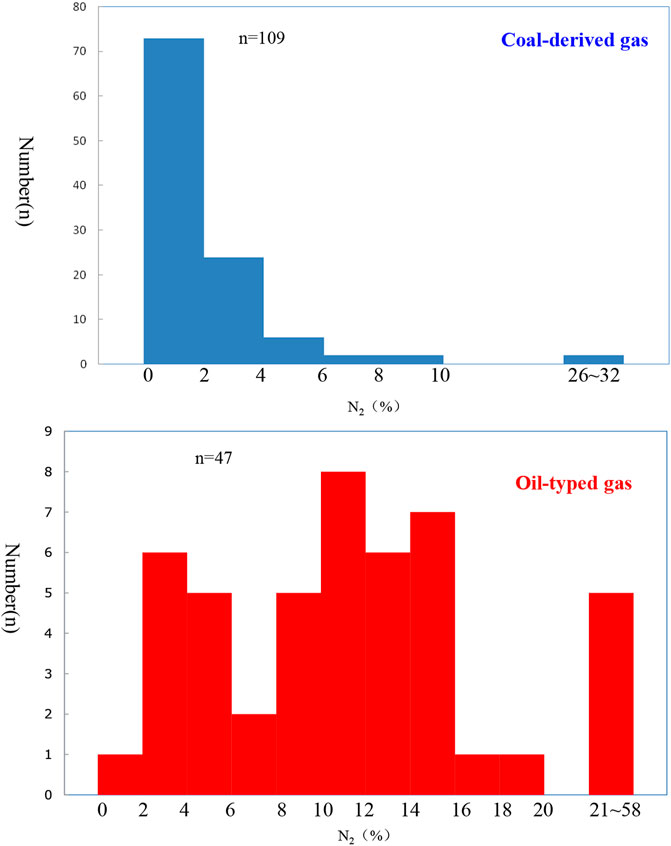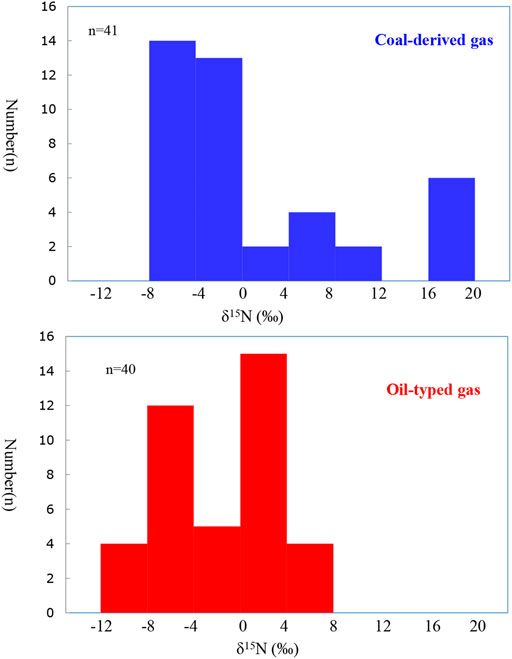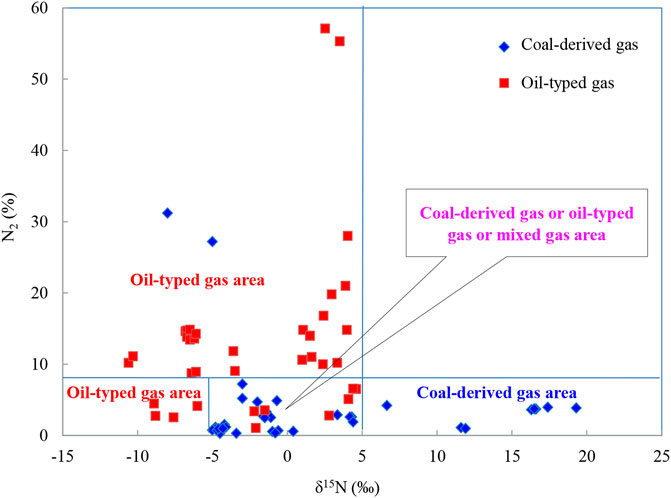- 1PetroChina Research Institute of Exploration and Development, Beijing,, China
- 2Key Laboratory of Gas Reservoir Formation and Development of CNPC, Langfang, China
- 3State Key Laboratory of Petroleum Resources and Prospecting, China University of Petroleum, Beijing, China
- 4University of Chinese Academy of Sciences, Beijing, China
Natural gases in China are mainly coal-derived gas, with assistance from oil-typed gas. At present, many genetic identification methods, from hydrocarbon composition and isotope to light hydrocarbon and biomarker indexes, have been formed, but combined methods from non-hydrocarbon gases are lacking. Based on compositions and isotopes geochemical characteristics and the differences of non-hydrocarbon nitrogen gas in coal-derived gas and oil-typed gas, and combining the isotopic geochemical characteristics of non-hydrocarbon helium, the comprehensive identification methods of coal-derived gas and oil-typed gas for hydrocarbon gases according to the associated non-hydrocarbon gases of nitrogen and helium are established and the preliminary applications have been engaged. The main recognitions are as follows:1)Coal-derived gas generally has relatively lower nitrogen abundance, mainly distributed from 0 to 31.2% with main frequency from 0 to 2%. Oil-typed gas, on the other hand, usually has relatively higher nitrogen abundance, mainly distributed from 1.1 to 57.1% with main frequency from 2 to 16%. 2) Coal-derived gas generally has relatively heavier nitrogen isotope values, mainly distributed from -8 to 19.3‰ with main frequency from -8 to 8‰.Oil-typed gas usually has relatively lower nitrogen isotope values, mainly distributed from -10.6 to 4.6‰ with main frequency from -8 to 4‰.3)The geochemical characteristic differences of coal-derived gas and oil-typed gas are mainly due to the fact that the sapropel parent material is relatively rich in nitrogen element and rich in light δ14N, while the humic parent material is relatively poor in nitrogen element and rich in heavy δ15N. The differences on thermal maturity of source rocks, the redox conditions of source rock sedimentary environment, and the salinity of water body are also important effective factors.4)Differences on nitrogen abundances and isotopes in coal-derived gas and oil-typed gas have great significance in genetic identification. The genetic identification chart of R/Ra-δ15N for organic and inorganic nitrogen in natural gas and the comprehensive joint identification charts of R/Ra-δ15N-N2 of nitrogen and helium for coal-derived gas and oil-typed gas have been established, and are of great reference in investigating the origins and sources of natural gas and guiding natural gas exploration in China.
Introduction
Natural gas is an environmentally friendly, low-carbon, effective, and clean energy. It occupies an important position in the world’s energy structure and is one of three important sources and targets in future energy development (natural gas, unconventional oil and gas, and new energy). The present proportion of natural gas in China’s energy structure (only about 8%) is lower than the world average (about 25%).
Natural gas is usually composed of more hydrocarbon gases such as CH4 (methane), C2H6 (ethane), C3H8 (propane), and C4H10 (butane), with lower or trace amounts of non-hydrocarbon gases such as CO2 (carbon dioxide), N2 (nitrogen), He (helium), Ne (neon), Ar (argon), Kr (krypton), and Xe (xeon). Non-hydrocarbon gases are very important components of natural gases, and usually have a close relation to hydrocarbon gases. Nitrogen, as a very important and common non-hydrocarbon gas component in natural gas, has closer physical properties with hydrocarbon gases than other non-hydrocarbon gas components, and has similar reservoir forming conditions with hydrocarbon gas reservoir. Therefore, studying the geochemical characteristics and origin of nitrogen in natural gases is helpful to find out the origin of formation, preservation, and enrichment of hydrocarbon gases. Nitrogen has two stable isotopes, 14N and 15N, with atmospheric abundances of 99.633 and 0.366% respectively (Rosman and Taylor, 1998). The atmosphere is the largest nitrogen reservoir on the earth. The origins of nitrogen in gas reservoirs are diverse. The total variation range of δ15N is 100‰, from about -50‰ to + 50‰, and most of them fall in the range of -10‰ to + 20‰(Hoefs, 1972; Heaton, 1986; Owens, 1987; Peterson and Fry, 1987; Kendall, 1998). As the nitrogen isotope value in natural gas is similar to or overlaps with the isotope value of many kinds of nitrogen-bearing materials in nature, it is difficult to identify the origin and source of nitrogen in natural gas only by using nitrogen isotope value and nitrogen content. The isotope value of associated helium is an important indirect indicator for assisted identification of the organic and inorganic origin of nitrogen in natural gas. There are also reports on the use of associated helium to determine the origin of mantle-derived magma nitrogen globally. So, a comprehensive judging method including nitrogen isotope of δ15N and other possible isotope indexes for effectively identifying organic and inorganic nitrogen needs to be established.
In China, natural gases are mainly coal-derived gas with assistance from oil-typed gas. Coal-derived gas contributes more to the gas reserves and production (Dai et al., 2014), and plays a pivotal role in promoting the development of China’s natural gas industry. The identification of oil-typed gas and coal-derived gas is of great significance for clarifying the origin and source of natural gas, guiding the exploration of natural gas, and promoting the rapid development of the natural gas industry. At present, three methods involving 28 comprehensive indicators and charts for identifying the origin of natural gas, especially for coal-derived gas and oil-typed gas, have been developed, such as carbon isotopes and compositions, light hydrocarbons, and biomarkers (Dai et al., 1988; Dai et al., 1992; Dai et al., 1993; Dai et al., 1994; Dai et al., 1995; Dai et al., 1996; Dai et al., 1999; Dai et al., 2005; Dai et al., 2008; Dai et al., 2009; Dai et al., 2014; Dai and Qi, 1989; Li Jian et al., 2001; Li Jian et al., 2005; Hu Guoyi et al., 2007). However, there are few comprehensive identification methods for coal-derived gas and oil-typed gas by jointly using the non-hydrocarbon gases. The compositions and isotopes of the non-hydrocarbon gases of helium and nitrogen contain rich geological information, which play an important tracing and indicative role in identifying the origin and source of hydrocarbon gases of natural gases. So it is necessary and meaningful to promote and advance the comprehensive identification index system for coal-derived gas and oil-typed gas from an non-hydrocarbon gas point of view. Based on geochemical characteristics of compositions and isotopes and their differences of non-hydrocarbon nitrogen gas in coal-derived gas and oil-typed gas, and combining the isotope geochemical characteristics of non-hydrocarbon helium, the comprehensive identification methods of coal-derived gas and oil-typed gas according to the associated non-hydrocarbon gases of nitrogen and helium need to be established.
In this study, the geochemical characteristics of non-hydrocarbon nitrogen gas and their differences in coal-derived gas and oil-typed gas are clarified first. Then the genesis of nitrogen in natural gases is identified and the reasons for the different geochemical characteristics of nitrogen are discussed. Finally, based on the difference of nitrogen content and δ15N value in coal-formed gas and oil-typed gas, combined with the R/Ra value of helium isotope, the genetic identification chart of R/Ra-δ15N for organic and inorganic nitrogen in natural gas and the comprehensive joint identification charts of R/Ra-δ15N-N2 of nitrogen and helium for identifying oil-typed gas and coal-derived gas jointly by nitrogen and helium are established and applied in the selected typical gas-bearing basins. The research results are of great significance for clarifying the origins and sources of natural gas and guiding natural gas exploration.
Research Situations
Studies on nitrogen of natural gas overseas have been carried out as early as the 1950s. Hoering and Moore (1958) first studied the changes of nitrogen isotope during the migration of the gas in the Permian gas reservoirs in the Republic of Germany and Groningen in the Netherlands. Jenden et al. (1988) summarized the data of 12,000 natural gas samples and found that the average content of N2 in natural gas is 3%, of which 10% of the gas samples have N2 ≥ 25%, 3.5% of gas samples have N2 ≥ 50%, and 1% of gas samples have N2 ≥ 90%. Studies on non-hydrocarbon gases of natural gas in China started in the 1980s. Zhang (1988) first analyzed the distribution and sources of nitrogen and the geochemical characteristics of nitrogen isotope in natural gas reservoirs in China and foreign countries, and concluded that nitrogen in gas reservoirs mainly came from the decomposition of organic matter, production of rock degassing, and atmospheric gas. Dai et al. (1992) calculated the analysis results of more than 1,000 gas samples in China and found that N2 ≤ 4% accounted for 76% and N2 ≤ 8% accounted for 86%. Since the 1990s, many domestic and foreign scholars have carried out a large number of studies on nitrogen composition, distribution, forming mechanism, origin and source, migration, accumulation, isotope analytical technique, nitrogen generation thermal simulation experiment, sedimentary environment, gas composition forecasting, and exploration risk reduction (Prisolov et al., 1991; Du, 1992; Zhu, 1994; Zhu and Shi, 1998; Krooss et al., 1995; Littke et al., 1995; Dai et al., 1995; Du et al., 1996; Zhu, 1999; He et al., 2001, 2011; Zeng, 2002; Shi et al., 2003; Chen et al., 2003; Chen, 2004; Liu et al., 2005; Liu et al., 2006; Qin et al., 2007; Zhang et al., 2008; Li et al., 2013; Xu et al., 2017; Chen et al., 2018), promoting rapid development of research into nitrogen in natural gases.
Research Areas and Experimental Methods
China’s natural gas is dominated by coal-derived gas, generally originating from coal-series source rocks, which are mainly distributed in the upper Paleozoic of the Ordos Basin, Upper Cretaceous in Kuche Depression of the Tarim Basin, and the Xujiahe formation of Upper Triassic in Sichuan Basin,. Coal-derived gas plays a pivotal role in natural gas reserves and production increases and promotes the rapid development of China’s natural gas industry. Oil-typed gas in China is mostly distributed in marine sediment strata in the three biggest marine basins: the Tarim, Sichuan, and Ordos Basin. Oil-typed gases also have an important position in China’s natural gas development, having encouraged many great exploration discoveries in deep and ancient strata, especially in recent years. Non-hydrocarbon nitrogen and helium gases are important components of natural gases, and have rich geological information in indirectly tracing and identifying the origin and source of associated hydrocarbon gases in natural gases. For the purpose of conducting deep studies on geochemical characteristic differences and their significance in nitrogen in coal-derived gas and oil-typed gas in China, typical coal-derived gases from the Tarim and Ordos Basin and typical oil-typed gases from the Tarim Basin are especially selected. Considering the importance and representativeness of typical coal-derived gas and oil-typed gas basins and gas fields, as well as gas samples sampling accessibility, the research areas of typical coal-derived gas fields referred to are Kela 2, Dabei, Dina 2, Akemomu, Kekeya, and Yaha gas fields in the Tarim Basin and the Sulige gas field in the Ordos Basin; the research areas of oil-typed gas fields referred to are Tazhong I, Hetianhe, Donghetang, Lunnan, and Hadexun oil and gas fields in the Tarim Basin. In order to make comprehensive and comparative studies, the nitrogen geochemical data from previous research on the Dongfang gas field in the YingQiong Basin are also selected (He et al., 2001,2011).
In order to minimize the impact of air pollution and sampling process on the accuracy of data measurement, samples should be collected as follows: 1) Use a stainless steel cylinder with double valves to collect natural gas samples in the study area to be tested, and the stainless steel cylinder should be vacuumed by a mechanical or molecular pump for more than 15 min, or to be below 10–2 Pa before collecting the sample; 2) connect the stainless steel cylinder to the valve of the natural gas well through a relief valve, then collect the mid-stage gas flow until the gas pressure in the stainless steel cylinder is 3–6 MPa after using the wellhead high-pressure natural gas to repeatedly flush the cylinder more than 6 times and for more than 15 min; and 3) Gas sample analysis and testing must be carried out within 1 week after sample collection.
In this paper, the typical coal-derived gases were sampled from the Kela 2, Dabei, Dina 2, Akemomu, Kekeya, and Yaha gas fields in the Tarim Basin, and Sulige gas field in the Ordos Basin. The typical oil-typed gases were sampled from the Tazhong I, Hetianhe, Lunnan, and Hadexun oil and gas fields in the Tarim Basin (Figure 1). The analysis of nitrogen component and isotope in natural gas was completed in the Key Laboratory of Gas Reservoir Formation and Development of China National Petroleum Corporation. The nitrogen composition was analyzed on an Agilent 6890 N gas chromatograph (GC) equipped with a thermal conductivity detector (TCD), using helium as the carrier gas. It was separated using a capillary column with 30 m × 0.32 mm × 20 μm PLOT Q. The gas chromatograph oven temperature was initially set at 30°C for 10 min, and programed at 10°C/min to 180°C and then isothermal at 180°C for 10 min. The precision of the nitrogen composition is estimated to be ±0.07%. The nitrogen isotopic compositions of natural gases were determined on the MAT 253 (GC/IRMS) isotopic mass spectrometer equipped with an Agilent 6890N Gas Chromatography with a 30 × 0.32 mm × 20 μm capillary column of HP Plot molesieve 5 Å molecular sieves. Helium was used as the carrier gas. Compositions of CO, N2, O2, CH4, and C2H6 can be completely separated by the above capillary column and the separated nitrogen is directly detected by MAT 253 isotopic mass spectrometer. The temperature of the GC oven was initially set at 30°C and maintained at such for 8 min, and then raised to 280°C at 10°C/min. The atmospheric nitrogen was selected as the standard material for nitrogen isotopic analysis. The nitrogen isotopic values of samples are reported in conventional δ notation in per mil (‰) relative to atmospheric nitrogen as the standard. The international atmospheric nitrogen isotope value of δ15N/14N = 0.00361 is defined as δ15N = 0‰. The nitrogen isotope of the gas sample was calculated based on atmospheric nitrogen as the standard according to the formula of δ15N=(Rsample/Rstandard -1) × 1000‰. In order to check the reliability of the instrument in the long-term detection process, air standard and a natural gas sample are selected for nitrogen isotope repeatability test at a relatively fixed time interval. The air standard was tested 5 times; the detected average nitrogen isotope value of δ15N for atmospheric nitrogen was −0.0065‰ and the standard deviation was 0.047‰. The gas sample was tested 7 times; the detected average nitrogen isotope of δ15N for gas sample was 4.6‰, and the standard deviation was 0.135‰. The tested results indicated that the repeatability of the test system was good and the stability of the instrument was reliable. In order to systematically study nitrogen in coal-derived gas and oil-typed gas, some previous research was collected and referenced (Du et al., 1996; He et al., 2001, 2011; Chen et al., 2001; Chen and Zhu, 2003; Liu and Xia, 2005; Liu et al., 2007; Li et al., 2013). Based on the experimental analysis and previous researcher’s data statistics, the geochemical characteristics of nitrogen component and isotope of coal-derived gas and oil-typed gas in China were systematically studied and discussed.
Results and Discussions
Differences on Geochemical Characteristics of Nitrogen in Coal-Derived Gas and Oil-typed Gas in China
According to the comparative analysis of nitrogen components of 109 coal-derived gas samples and 47 oil-typed gas samples in the nitrogen content distribution histogram of coal-derived gas and oil-typed gas in China (table 1), it can be seen that the content of nitrogen in coal-derived gas is mainly distributed from 0 to 31.2%, with main frequency from 0 to 2%; the content of nitrogen in oil-typed gas, meanwhile, is mainly distributed from 1.1 to 57.1%, and with main frequency from 2 to 16% (Figure 2). From Figure 2, it can also be seen that the nitrogen component content of coal-formed gas and oil-typed gas can be obviously divided by 2% in the dominant frequency distribution.
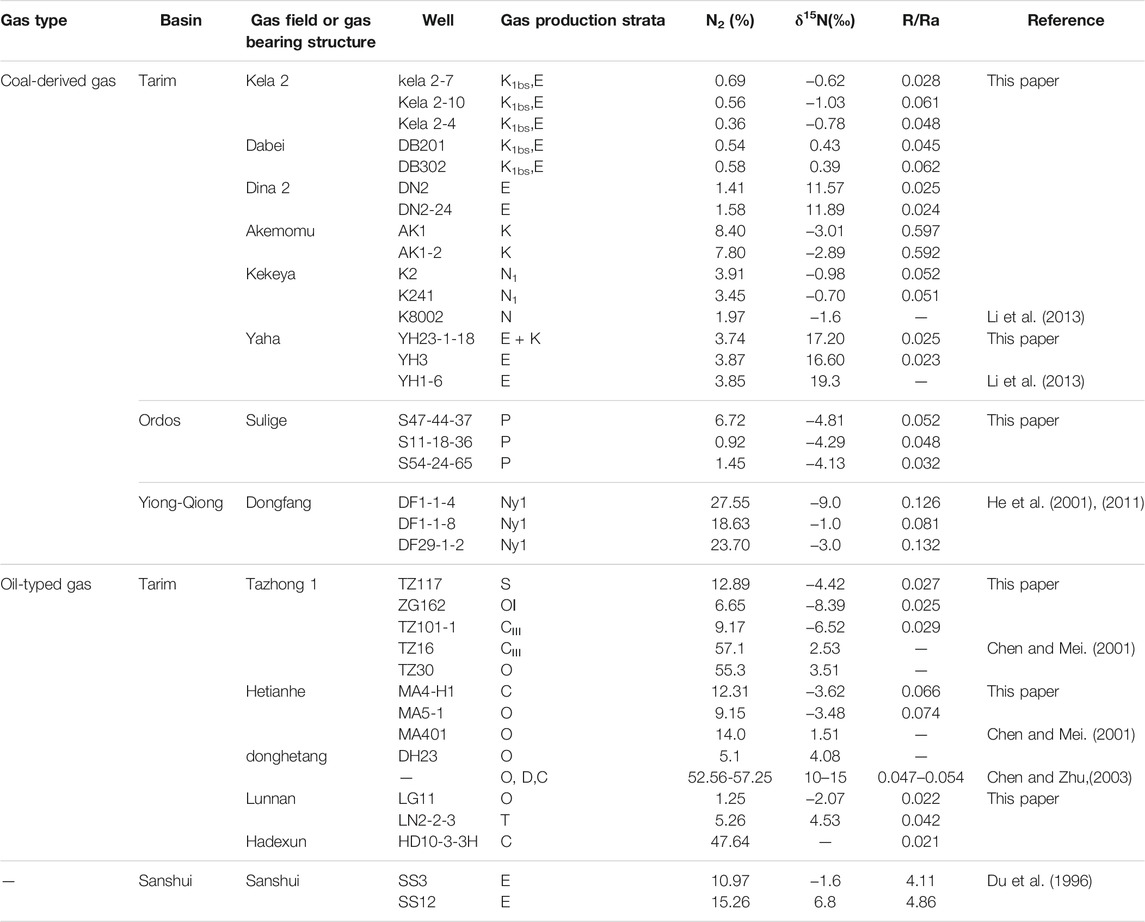
TABLE 1. Composition and isotope data of non-hydrocarbon gases of nitrogen and helium in some typical coal-derived gas and oil-typed gas in China.
From the relationship between nitrogen content and ethane isotope δ13C2 of coal-derived gas and oil-typed gas in China, it can be obviously seen that oil-typed gas has a relatively high nitrogen content with most ethane isotope δ13C2 generally from −41.5‰ to −30‰, while coal-derived gas has a relatively low nitrogen content with most ethane isotope δ13C2, generally from −26.5‰ to −16‰ (Figure 3). From Figure 3, it can be seen that the nitrogen content of coal-derived gas and oil-typed gas is significantly different and distinct in total distributed range, and the overlapped areas of nitrogen content is mostly less than 10% in low-content areas.
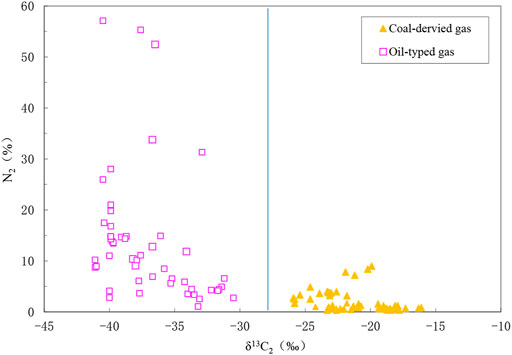
FIGURE 3. Relationship between nitrogen content and ethane isotopeδ13C2 of coal-derived gas and oil-typed gas in China.
From the histogram depicting nitrogen isotope distribution of coal-derived gas and oil-typed gas in China, it can be concluded that the value of the nitrogen isotope (δ15N) of 41 coal-derived gas samples is totally distributed from −8 to 19.3‰ with main frequency from −8 to 8‰, while the value of the nitrogen isotopes of 40 oil-typed gas samples is generally distributed from −10.6 to 4.6‰ with main frequency from −8 to 4‰(Figure 4). From Figure 4, it can be seen that the nitrogen isotopic composition of coal-derived gas and oil-typed gas are obviously overlapped from −8 to 8‰ in their distribution range with the dominant frequency distributed from −8 to 4‰.
From the relationship between nitrogen isotope δ15N and ethane isotopeδ13C2 of coal-derived gas and oil-typed gas in China, it can be obviously seen that the distribution values of the nitrogen isotopes in coal-derived gas are relatively heavier than these of oil-typed gas. Oil-typed gas generally has relatively lighter nitrogen isotope from −11 to 5‰ with most ethane isotope δ13C2 generally from −38 to -29‰, while coal-derived gas has relatively heavier nitrogen isotope from −4 to 20‰ with most ethane isotope δ13C2 generally from −26 to −17.5‰ (Figure 5). From Figure 5, it can also be concluded that there is an overlap of nitrogen isotopic composition that exists in coal-derived gas and oil-typed gas, and the overlapped area is generally from −4 to 5‰ with limited data distribution points. The reason for this phenomenon will be discussed and given in the following section.
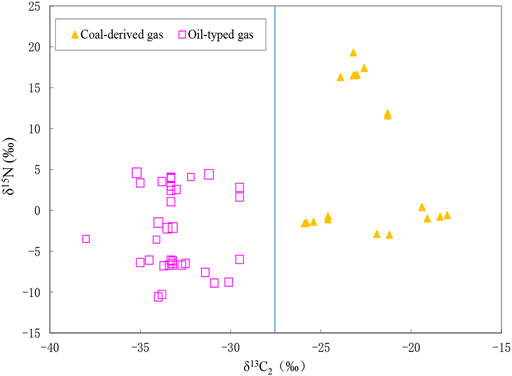
FIGURE 5. Relationship between nitrogen isotope δ15N and ethane isotope δ13C2 of coal-derived gas and oil-typed gas in China.
In general, from the relationship between nitrogen content and isotope of coal-derived gas and oil-typed gas in China, the content of nitrogen is relatively low and the δ15N is relatively heavy in the coal-derived gas, while the content of nitrogen is relatively high and the δ15N is relatively light in oil-typed gas (Figure 6).

FIGURE 6. Relationship between nitrogen content and isotope in coal-derived gas and oil-typed gas in China.
Discussions on Nitrogen Genesis and Reasons for Geochemical Characteristics Differences in Coal-Derived Gas and Oil-typed Gas in China
Nitrogen, as a very important and common non-hydrocarbon gas component in natural gas, has closer physical properties with hydrocarbon gas than other non-hydrocarbon gas components and has similar reservoir forming conditions with hydrocarbon gas reservoir. Therefore, studying the geochemical characteristic and origin of nitrogen in natural gases is helpful to find out the origin of formation, preservation, and enrichment of hydrocarbon gases. By exploring the geochemical characteristics and source of nitrogen in natural gases, great value will be added to the study of hydrocarbon generation, migration, and accumulation in the basin, forecasting favorable gas exploration areas.
The atmosphere is the largest nitrogen reservoir on the earth. About 99% of the nitrogen in the near surface environment exists in the atmosphere or is dissolved in seawater in the form of nitrogen. There is little nitrogen in the biosphere, but it is one of the most indispensable elements in the process of life. The origins and sources of nitrogen in gas reservoirs are diverse, and many scholars have carried out a lot of research on nitrogen in natural gases. The total variation range of δ15N is 100‰, from about −50 to +50‰, and most of them fall in the range of −10 to +20‰. Nitrogen from igneous rocks ranges from -16 to +31‰; nitrogen in the hydrosphere is represented by that in the ocean water, ranging from -8‰ to+10‰; nitrogen in plants ranges from −10 to+22‰; oil and coal fall within the range of modern biology, ranging from 0 to +15‰; δ15N of natural gas varies greatly ranging from −45 to+45‰; δ15N of extraterrestrial matter varies the most, ranging from −40 to+100‰, while the value of Martian atmosphere is as high as 700‰ (Hoefs, 1972; Heaton, 1986; Owens, 1987; Peterson and Fry, 1987; Kendall, 1998). According to the origins and sources, nitrogen in natural gas may be from a number of sources: the atmosphere, microbial ammoniation or denitrification, thermal ammoniation and thermal pyrolysis of organic matters in source rocks, high temperature metamorphism of nitrogenous minerals in sedimentary rocks, or the deep crust and upper mantle. There are certain differences in geochemical characteristics of nitrogen from different sources. Because of the overlapping distribution of δ15N in different types of nitrogen (nitrogen isotope value in natural gas is similar to or overlaps with the isotope value of many kinds of nitrogen-bearing materials in nature), it is difficult to identify the origin and source of nitrogen in natural gas only by using nitrogen isotope value and nitrogen content. To solve this problem, it is necessary to combine geological information with other gas geochemical data for comprehensive identification. The isotope value of associated helium is an important indirect indicator for assisted identification of the organic and inorganic origin of nitrogen in natural gas. There are also reports on the use of associated helium to determine the origin of mantle-derived magma nitrogen globally. For example, the nitrogen in some high nitrogen natural gas in the Grand Canyon of California in the United States belongs to magma source (Jenden et al., 1988), the nitrogen in some hot spring gas in China is derived from magma (Dai et al., 1988), and the gas in Sanshui Basin of Guangdong also has magma-sourced nitrogen (Du et al., 1996).
Based on the above studies, R/Ra-δ15N indexes and charts to identify organic and inorganic nitrogen have been established by using R/Ra (R and Ra denote 3He/4He of helium in natural gas and air respectively) and nitrogen isotope of δ15N (Figure 7): ① When R/Ra ≤ 0.2, the nitrogen in natural gas is generally organic in genesis and probably originated from biogenic chemical affection (such as microbial ammoniation or denitrification) or thermal pyrolysis of organic matters in source rocks during diagenetic stage (such as thermal ammoniation in mature and high mature stage or cracking action in over-mature stage); ② When R/Ra ≥ 1 and nitrogen isotope of δ15N range from -16 to 31‰, the nitrogen is usually inorganic in genesis from volcano-mantle origin; ③When 0.2<R/Ra < 1 and 1‰<δ15N < 4‰, the nitrogen in natural gas is probably inorganic in genesis and originated from high-temperature metamorphism of nitrogenous minerals in sedimentary rocks; ④ When 0.2<R/Ra < 1 and δ15N ≥ 4‰ or ≤1‰, the nitrogen is usually of mixed genesis of organic and inorganic; and ⑤ When R/Ra ≈ 1 and δ15N ˜ 0, the nitrogen in natural gas is of atmospheric genesis.
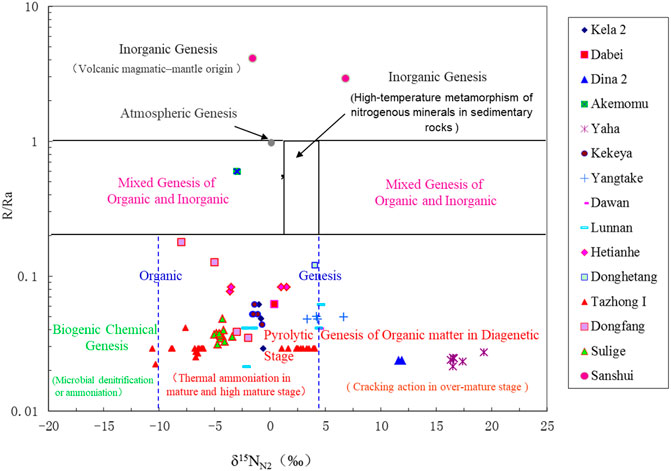
FIGURE 7. Genesis identification chart of R/Ra-δ15N for organic and inorganic nitrogen in natural gases in China.
The genesis identification chart of R/Ra-δ15N for organic and inorganic nitrogen has been used to identify the genesis of nitrogen in natural gases from these selected gas fields in the Tarim, Ordos, and Ying-Qiong basin. The 3He/4He value of helium on natural gases in the gas fields of Kela 2, Dabei, Dina 2, Kekeya, Yaha, Sulige, Tazhong I, Hetianhe, Donghetang, Lunnan, and Hadexun are basically at the order of 10–8, and R/Ra<0.1; the helium is typically from the crust. So, according to the R/Ra-δ15N chart (Figure 7), the nitrogen in natural gases of these gas fields are identified from crustal organic origin.
In coal-derived gas, the content of nitrogen is relatively low and the δ15N is relatively heavy, while in oil-typed gas the content of nitrogen is relatively high and the δ15N is relatively light. The geochemical characteristic differences of coal-derived gas and oil-typed gas are mainly due to the fact that the sapropel parent material is relatively rich in nitrogen element and rich in light δ14N, while the humic parent material is relatively poor in nitrogen element and rich in heavy δ15N. Sapropel organic matter is mainly originated from aquatic organisms (having an average protein content of 10.3%) and contains a large amount of protein and nucleic acid which provides a sufficient source for the production of N2; humic organic matter is mainly originated from terrestrial plants (having an average protein content of 2.0%) and is poor in protein and acid and rich in carbon with a limited source of N2 (Chen et al., 2001; Zhu and Shi, 1998). Therefore, the nitrogen content of sapropelic natural gas is much higher than that of humic natural gas. The nitrogen isotope values of source rocks in a marine sedimentary environment are generally lighter than those source rocks in a continental sedimentary environment. The nitrogen isotope analysis results of some hydrocarbons and kerogen in different sedimentary environments in China show that (Chen and Mei, 2001) the δ15N of hydrocarbons in a freshwater environment is about 3–6‰. The nitrogen isotope of sedimentary organic matter formed in saline and brackish water environment is the heaviest, and the δ15N is generally more than 10‰. The δ15N of organic matter in Paleozoic marine carbonate rocks and generated hydrocarbons is close to 0 or less than 0. In addition, the release of nitrogen is closely related to the thermal evolution of source rocks. In the immature stage, the protein of deposited organic matter will be hydrolyzed to produce amino acids. Amino acids will produce NH3 through microbial ammoniation, and NH3 will be further decomposed into N2. After entering the mature stage, some nitrogen-containing compounds begin to ammoniate under thermal catalysis to produce ammonia until nitrogen is formed. Since the heat received by the organic matter in the mature stage has not yet reached the activation energy required for the pyrolysis and denitrification of nitrogen-containing organic compounds, a considerable amount of nitrogen still exists in the deposited organic matter. In the over mature stage of Ro>2.0%, especially when Ro>3.0%, the thermal energy received by the deposited organic matter begins to fully reach the activation energy required for the pyrolysis and denitrification of nitrogen-containing organic matter, and then produces a large number of nitrogen. Littke et al. (1995) and Kroos et al. (1995) considered that nitrogen formed by the pyrolysis of sedimentary organic matter in high to over mature stage is the main source of high nitrogen gas in petroliferous basins. Therefore, the thermal maturity of source rock has great influences on nitrogen content in natural gas. In addition, the redox conditions of source rock sedimentary environment and the salinity of water body have different heterogeneity and are also important effective factors (Chen et al., 2015).
Discussions on the Tracing Implication of Geochemical Characteristics Differences of Nitrogen in Coal-Derived Gas and Oil-typed Gas
China’s natural gas is mainly coal-derived gas, supplemented by oil-typed gas. Coal-derived gas is the main body of China’s natural gas reserves and production growth, and plays an important role in promoting the development of China’s natural gas industry. At present, about 28 comprehensive identification indexes and charts have been formed for the identification of coal-derived gas and oil-typed gas in three categories: carbon isotope and component of natural gas, light hydrocarbon, and biomarker. Non-hydrocarbon gas nitrogen and helium are important components of natural gas and are closely related to hydrocarbon gas. The components and isotopes of non-hydrocarbon gas contain very rich geological information, so they are important tracers and indicators for identifying the origins and sources of natural gas. However, there are few reports on genetic identification charts and methods on coal-derived gas and oil-typed gas by using nitrogen and helium jointly. This study has clarified the differences in the geochemical characteristics of nitrogen in coal-derived gas and oil-typed gas and considered the R/Ra ratio of helium isotope from crust and mantle sources. Finally, this paper established the comprehensive charts of R/Ra-δ15N-N2 for identifying coal-derived gas and oil-typed gas. Geological applications have achieved good results and are of great significance for deepening the research on the origins and sources of natural gas and guiding natural gas exploration. It is of great significance to optimize the related indexes of nitrogen and helium to identify coal-derived gas and oil-typed gas, which is helpful to enrich the existing identification index system of coal-derived gas and oil-typed gas.
Based on the differences in nitrogen content and δ15N value in coal-formed gas and oil-typed gas, combined with the R/Ra value of helium isotope, the R/Ra-δ15N-N2 identification indexes and charts of coal-formed gas and oil-typed gas jointly identified by nitrogen and helium are established (Figure 7, Figure 8). For the methods process, the R/Ra-δ15N chart was used to identify the organic and inorganic origin of nitrogen in natural gas (Figure 7). When the nitrogen in natural gas was identified as an organic origin, then the δ15N-N2 chart and indexes of nitrogen was used to judge the associated hydrocarbon gas to be coal-derived gas or oil-typed gas subsequently (Figure 8). The specific identification index values of this method are as follows (Figure 8). When the R/Ra value of helium isotope in natural gas is less than 0.2 or 3He/4He value is less than 2.8 × 10–7 (to ensure that the hydrocarbon gas associated with helium and nitrogen in natural gas is crustal organic origin): ① Because the humic parent material from higher plants is poor in nitrogen and relatively heavy in δ15N, when the content of nitrogen is less than or equal to 9% and the δ15N value is greater than or equal to 5%, it is generally coal-derived gas; ② Because the Sapropel parent material from lower zooplankton is rich in nitrogen and relatively light in δ15N, when the content of nitrogen is greater than or equal to 9% and the value of δ15N is less than or equal to 5‰, or the content of nitrogen is less than 9% and the value of δ15N is less than or equal to −5‰, it is usually oil-typed gas; ③When the content of nitrogen is less than or equal to 9%, and δ15N is from−5 to 5‰, it may be coal-formed gas or oil-typed gas or a mixture of the two, which can be further distinguished according to alkane value of δ15C.
The comprehensive charts and indicators of R/Ra-δ15N-N2 have been used to identify coal-derived gas and oil-typed gas from some gas fields in the Tarim and Ordos Basins. The 3He/4He value of helium on natural gases in the Tarim and Ordos Basin is basically at the order of 10–8, and R/Ra<0.1; the helium is typically from the crust. So, according to the R/Ra-δ15N chart (Figure 7), the nitrogen of selected natural gases can be identified as originating from organic materials in the crust. Then, the established δ15N-N2 chart (Figure 8) can be used for coal-derived gas and oil-typed gas identification according to geochemical indexes of accompanied nitrogen, and the final genetic identification is shown in Figure 9 and the detailed results are as follows: ①the Tazhong I and the Hetianhe gas fields fall onto the oil-typed gas zone, so the natural gases are oil-typed gases; ②Dina 2 and Yaha gas fields completely fall onto the coal-derived gas zone, so the natural gases are coal-derived gases; ③Sulige gas field, Kekeya gas field, and Lunnan oil and gas field fall onto the mixture zone, and the oil-typed gas of Lunnan oil and gas field was distinguished from the coal-derived gas of Sulige and Kekeya gas fields by the alkane carbon isotope (Figure 9). The results obtained by this method are consistent with those obtained by the carbon isotope of conventional hydrocarbon gas.
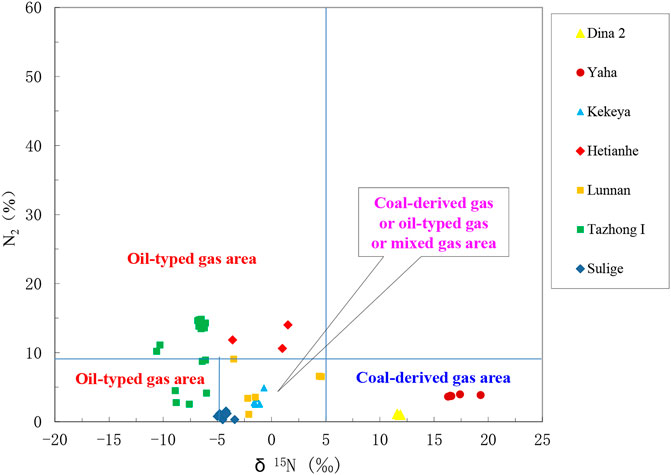
FIGURE 9. Comprehensive genesis identification application of R/Ra-δ15N-N2 for some natural gases in the Tarim and Ordos basin.
Conclusions
1) Coal-derived gas generally has relatively lower nitrogen abundances, mainly distributed from 0 to 31.2% with main frequency from 0 to 2%. Oil-typed gas usually has relatively higher nitrogen abundances, mainly distributed from 1.1 to 57.1% with main frequency from 2 to 16%.
2) Coal-derived gas generally has relatively heavier nitrogen isotope values mainly distributed from −8 to 19.3‰ with main frequency from −8 to 8‰. Oil-typed gas, meanwhile, usually has relatively lower nitrogen isotope values, mainly distributed from -10.6 to 4.6‰ with main frequency from −8 to 4‰.
3) Coal-derived gas has a relatively low nitrogen content and heavy δ15N value, while oil-typed gas has a relatively high nitrogen content and light δ15N value. The geochemical characteristic differences of coal-derived gas and oil-typed gas are mainly due to the fact that the sapropel parent material is relatively rich in nitrogen element and rich in light δ14N, while the humic parent material is relatively poor in nitrogen element and rich in heavy δ15N, as well as the differences on thermal maturity of the source rocks. In addition, the redox conditions of source rock sedimentary environment and the salinity of water body are also important effective factors.
4) The differences in the geochemical characteristics of nitrogen abundances and isotopes in coal-derived gas and oil-typed gas are of great significance for genetic identification. The genetic identification chart of R/Ra-δ15N for organic and inorganic nitrogen in natural gas and the comprehensive joint identification charts of R/Ra-δ15N-N2 of nitrogen and helium for coal-derived gas and oil-typed gas have been established, and are of great importance in investigating the origins and sources of natural gas and guiding natural gas exploration in China.
Data Availability Statement
The original contributions presented in the study are included in the article/Supplementary Material, further inquiries can be directed to the corresponding authors.
Author Contributions
All authors listed have made a substantial, direct, and intellectual contribution to the work and approved it for publication.
Funding
This paper was sponsored by the Major Project of National Special Science and Technology (2016ZX05007-003), the Strategic Priority Research Program of the Chinese Academy of Sciences (XDA14010403), and the Program of PetroChina Company Limited (2018D-500802, 2019B-0604, and 2016ycq03).
Conflict of Interest
Authors WX, LJ, YC, LZ, WY, LJ, YC, HA and GS were employed by RIPED/PetroChina. The remaining authors declare that the research was conducted in the absence of any commercial or financial relationships that could be construed as a potential conflict of interest.
The authors declare that this study received funding from PetroChina Company Limited. The funder was involved in the study design, collection, analysis, interpretation of data, the writing of this article or the decision to submit it for publication.
Publisher’s Note
All claims expressed in this article are solely those of the authors and do not necessarily represent those of their affiliated organizations, or those of the publisher, the editors and the reviewers. Any product that may be evaluated in this article, or claim that may be made by its manufacturer, is not guaranteed or endorsed by the publisher.
Acknowledgments
Thanks to anonymous reviewers for their constructive suggestions.
References
Chen, C. P., Mei, B. W., and Chao, Y. C. (2004). Nitrogen Isotope Geochemistry of Crude Oils in Some of Chinese Basins. Sci. China:Series D 34 (8), 721–727. doi:10.3321/j.issn:1006-9267.2004.08.004
Chen, C. P., and Mei, B. W. (2001). Charaterisitcs of Nitrogen Isotope in Different Depositional Enviroments in Chin. Oil Geology. 22 (3), 207–209. (In Chinese). doi:10.3321/j.issn:0253-9985.2001.03.003
Chen, C. P., Mei, B. W., and Zhu, C. S. (2001). Nitrogen Isotopic Compostion and Distribution of Natural Gases in Tarim basin. Geology. Geochem. 29 (4), 46–49. (In Chinese). doi:10.3969/j.issn.1672-9250.2002.01.008
Chen, C., Zhao, F. H., Ren, D. Y., and Miao, X. N. (2018). Preliminary Study on the Characteristics of Nitrogen Isotopic Composition in Chinese Coals. Acta Geol. Sinica 92 (9), 1959–1969. (In Chinese). doi:10.3969/j.issn.0001-5717.2018.09.014
Chen, J. F., Xu, X. M., and Shi, S. B. (2015). Geochemical Characteristics of Crude Oil Nitrogen Isotopes in Different Sedimentary Environments. J. China Univ. Pet. (Edition Nat. Science) 39 (5), 1–6. (In Chinese). doi:10.3969/j.issn.1673-5005.2015.05.001
Chen, J. F., and Zhu, Y. N. (2003). The Origin of Meolecular Nitrogen in Natural Gas and Geochemical Characters of Melecular Nitrogen in Natural Gas from East Part of Tarim basin. Nat. Gas Geosci. 14 (3), 172–176. (In Chinese). doi:10.3969/j.issn.1672-1926.2003.03.003
Dai, J. X., Song, Y., Dai, C. S., Chen, A. F., Sun, M. L., Liao, Y. S., et al. (1995). Forming Conditions of Inorganic Natural Gas in east China. Beijing: Science Press, 195–202. (In Chinese).
Dai, J. X. (1988). Carbon Isotopic Composition Characteristics and Genesis of Liuhuangtang Natural Gas in Tengchong County,Yunan Province. Chin. Sci. Bull. 33 (15), 1168–1170. doi:10.1360/csb1988-33-15-1168
Dai, J. X. (1993). Coal-derived Gas and Oil-Typed Gas Identification by Utilizing Light Hydrocarbon. Pet. Exploration Development 5, 26–32. (In Chinese).
Dai, J. X. (2014). Coal-derived Large Gas Fields and Their Gas Sources in China. Beijing: Science Press, 212–233.
Dai, J. X., Hu, G. Y., Ni, Y. Y., Li, J., Luo, X., Yang, C., et al. (2009). The Distribution Characteristics of Natural Gases in Eastern China. Nat. gas Geosciences 20 (4), 471–487. (In Chinese).
Dai, J. X. (1992). Identification of Different Alkane Gas. Sci. China Ser. B: Chem. 22 (2), 185–193.
Dai, J. X., Yang, S. F., Chen, H. L., and Shen, X. H. (2005). Geochemistry and Occurrence of Inorganic Gas Accumulations inChinese Sedimentary Basins. Org. Geochem. 36 (12), 1664–1688. doi:10.1016/j.orggeochem.2005.08.007
Dai, J. X., and Qi, H. F. (1989). Relationship of δ13C and Ro of Coal-Derived Gas in China. Chin. Sci. Bull. 34 (9), 690–692. doi:10.1360/csb1989-34-9-690
Dai, J. X., Song, Y., and Zhang, H. F. (1994). Gas Accumulation Zones in China. Beijing: Sciences Press, 194–198. (In Chinese).
Dai, J. X. (1999). Twenty Year's Important Progress on Coal-Derived Gas Researches in China. Pet. Exploration Development 26 (3), 1–10. (In Chinese).
Dai, J. X., Zou, C. N., Zhang, S. C., Li, J, Ni, Y. Y., Hu, G. Y., et al. (2008). Identification of Organic and Inorganic Alkane Gases. Sci. China Ser. D: Earth Sci. 38 (11), 1329–1341. doi:10.3321/j.issn:1006-9267.2008.11.001
Dai, J. X., Song, Y., and Dai, C. S. (1996). Geochemistry and Accumulation of Carbon Dioxide Gases in China. AAPG Bull. 80 (10), 1615–1626. doi:10.1306/64eda0d2-1724-11d7-8645000102c1865d
Du, J. G., Liu, W. H., Shao, B., and Eckhard, B. (1996). Geochemical Characteristics of Nitrogen in Natural Gases. Acta Sedimentologica Sinica 14 (1), 143–148. (In Chinese). doi:10.3321/j.issn:1006-9267.2004.08.004
Du, J. G. (1992). Research Situation of Nitrogen in Natural Gases. Nat. gas Geosciences 3 (2), 36–40. (In Chinese).
He, J. X., Li, M. X., Chen, W. H., and Chen, S. H. (2001). Origin of Carbon Dioxide in Natural Gas in Ying-Qiong Basin and its Comprehensive Gas Source Discrimination. China Offshore Oil and Gas (Geology) 21 (3), 15–21. (In Chinese). doi:10.3321/j.issn:1000-0976.2001.03.005
He, J. X., Ma, W. H., Zhu, H. Y., and Gong, X. F. (2011). Integrated Identification and Determination of Genetic Types and Accumulation Time in the Marginal basin of Northern South China Sea. Geology. China 38 (1), 15–21. (In Chinese). doi:10.3969/j.issn.1000-3657.2011.01.016
Heaton, T. H., Vogel, J. C., Gertrud, V. L. C., and Collett, G. (1986). Climatic Influence on the Isotopic Composition of Bone Nitrogen. Nature 322 (6082), 822–823. doi:10.1038/322822a0
Hoering, T. C., and Moore, H. E. (1958). The Isotopic Composition of the Nitrogen in Natural Gases and Associated Crude Oils. Geochimica et Cosmochimica Acta 13, 225–232. doi:10.1016/0016-7037(58)90024-3
Hu, G. Y., Li, J., Li, Z. S., Luo, X., Sun, Q. W., and Ma, C. H. (2007). Discussion on Light Hydrocarbon Indexs of Natural Gas Identification. Sci. China Ser. D: Earth Sci. 37 (Suppl. p), 111–117. (In Chinese).
Jenden, P. D., Kaplan, I. R., Poreda, R., and Craig, H. (1988). Origin of Nitrogen-Rich Natural Gases in the California Great Valley: Evidence from Helium, Carbon and Nitrogen Isotope Ratios. Geochimica et Cosmochimica Acta 52 (4), 851–861. doi:10.1016/0016-7037(88)90356-0
Kendall, C. (1998). in Isotope Tracers in Catchement Hydrology. Editors C. Kendall, and J. J. Mcdonnell (Elsevier Sci.), 519–576. doi:10.1016/b978-0-444-81546-0.50023-9
Krooss, B. M., Littke, R., Müllera, B., Frielingsdorf, J., Schwochau, K., and Idiz, E. F. (1995). Generation of Nitrogen and Methane from Sedimentary Organic Matter :implication on the Dynamics of Natural Gases Accumulations. Chem. Geology. 126 (3/4), 291–318. doi:10.1016/0009-2541(95)00124-7
Li, J., Li, Z. S., Wang, D. L., Li, J., Chen, H. Z., Xie, Z. Y., et al. (2013). Geochemical Characteristics and N2 Source of Nigtrogen Riched Natural Gas in Tarim basin. Acta Petrolei Sinica 34 (S.1), 102–111. (In Chinese). doi:10.7623/syxb2013S1012
Li, J., Luo, X., Shan, X. Q., Ma, C. H., Hu, G. Y., Yan, Q. T., et al. (2005). Resevoir Forming Characteristics of Upper Palezoic Gases in Ordos basin. Pet. Exploration Development 32 (4), 54–59. (In Chinese).
Li, J., Xie, Z. Y., Li, Z. S., Luo, X., Hu, G. Y., and Gong, S. (2001). A Gas Source Study for Kuqa Depression of Tarim Basin. Pet. Exploration Development 28 (5), 29–32. (In Chinese).
Littke, R., Krooss, B. M., Idiz, E., and Frielingsdorf, J. (1995). Molecular Nitrogen in Natural Gas Accumulations:generation from Sedimentary Orgaric Matter at High Temperatures. AAPG 79 (3), 410–430. doi:10.1306/8d2b1548-171e-11d7-8645000102c1865d
Liu, Q. Y., Dai, J. X., Liu, W. H., Qin, S. F., and Zhang, D. W. (2007). Geochemical Characteristics and Genesis of Nitrogen in Natural Gas from Tarim basin. Oil Gas Geology. 28 (1), 12–17. (In Chinese). doi:10.11743/ogg20070102
Liu, Q. Y., Liu, W. H., Krooss , B. M., Wang , W. C., and Dai, J. X. (2006). Advances in Nitrogen Geochemistry of Natural Gas. Natural Gas Geoscience 17 (1), 119–124. doi:10.3969/j.issn.1672-1926.2006.01.025
Liu, Z. L., and Xia, B. (2005). The Genesis of Molecular Nitrogen of Natural Gases and its Exploratioin Ris Coefficient in Tarim basin. Nat. Gas Geosci. 16 (2), 224–228. (In Chinese). doi:10.3969/j.issn.1672-1926.2005.02.020
Owens, N. J. P. (1987). Natural Variations in 15N in the marine Environment. Adv. Mar. Biol. 24, 390–451. (In Chinese). doi:10.1016/S0065-2881(08)60077-2
Peterson, B. J., and Fry, B. (1987). Stable Isotopes in Ecosystem Studies. Annu. Rev. Ecol. Syst. 18, 293–320. doi:10.1146/annurev.es.18.110187.001453
Prisolov, Z. M., Subbotin, E. S., Tifomirov, B. B., and Sun, Y. X. (1991). Isotopic Composition of Molecular Nitrogen of Natural Gas in Soviet. Nat. gas Geosciences 2 (4), 162–167. (In Chinese).
Qin, S., Dai, J., and Liu, X. (2007). The Controlling Factors of Oil and Gas Generation from Coal in the Kuqa Depression of Tarim Basin, China. Int. J. Coal Geology. 70, 255–263. doi:10.1016/j.coal.2006.04.011
Rosman, K. J. R., and Taylor, P. D. P. (1998). Isotopic Compositions of the Elements 1997 (Technical Report). Pur. Appl. Chem. 70, 217–235. doi:10.1351/pac199870010217
Shi, J. N., Zeng, Z. P., Zhou, L. Y., and Liao, C. J. (2003). Research on Genetic Mechanism of Non-hydrocarbon Gas in Chinese Sedimental Basins. Spec. oil gas reservoir 10 (2), 5–9. (In Chinese). doi:10.3969/j.issn.1006-6535.2003.02.002
Xu, X. M., Chen, J. F., Shi, S. B., Wang, S. Q., Sun, W. L., and Shen, B. (2017). Nitrogen Isotope Distribution Characteristics of Different Polar Nitrogen Compounds in Crude Oil. Bull. Mineralogy Petrology Geochem. 36 (1), 150–154. (In Chinese). doi:10.3969/j.issn.1007-2802.2017.01.017
Zeng, Z. P. (2002). Analysis on Nitrogen Genesis of Sedimental Basins in China. Nat. gas Geosciences 13 (Z1), 29–33. (In Chinese). doi:10.3969/j.issn.1672-1926.2002.03.006
Zhang, L., Hu, G. Y., Xie, Z. Y., Liu, G. D., Wang, X. B., and Xiang, J. (2008). Pyrrole Nitrogen Compound for Tracing the Natural Gas Migration: A Case from the Second Section of Xujiahe Formation in Pingluoba-Qiongxi Area. Nat. Gas Geosicence 19 (2), 250–254. (In Chinese).
Zhang, Z. S. (1988). Geological Geochemistry of Nitrogen in Gas Reservoir. Geology. Geochem. 2, 51–56. (In Chinese).
Zhu, Y. N. (1994). Developments in Geochemistry of Non-hydrocarbon Constituents of Natural Gas. Adv. Earth Sci. 9 (4), 50–57. (In Chinese).
Zhu, Y. N. (1999). Genesis and Identification of Molecular Nitrogen in Natural Gases. J. China Univ. Pet. (Edition Nat. Sciences) 23 (2), 22–26. (In Chinese). doi:10.3321/j.issn:1000-5870.1999.02.006
Keywords: comprehensive identification, oil-typed gas, coal-derived gas, helium, nitrogen, geochemical characteristics differences
Citation: Xiaobo W, Jian L, Chunxia Y, Zhisheng L, Jianfa C, Yue Z, Yifeng W, Jin L, Chunlong Y, Aisheng H and Shouguo G (2021) Differences on Geochemical Characteristics and Their Implicating Significances of Nitrogen in Coal-Derived Gas and Oil-typed Gas in China. Front. Earth Sci. 9:636193. doi: 10.3389/feart.2021.636193
Received: 01 December 2020; Accepted: 13 September 2021;
Published: 14 October 2021.
Edited by:
Giovanni Martinelli, National Institute of Geophysics and Volcanology, ItalyReviewed by:
Weijiao Ma, China University of Petroleum (Huadong), ChinaHaiping Huang, China University of Geosciences, China
Weilong Peng, SINOPEC Petroleum Exploration and Production Research Institute, China
Alexandra Hakala, National Energy Technology Laboratory (DOE), United States
Copyright © 2021 Xiaobo, Jian, Chunxia, Zhisheng, Jianfa, Yue, Yifeng, Jin, Chunlong, Aisheng and Shouguo. This is an open-access article distributed under the terms of the Creative Commons Attribution License (CC BY). The use, distribution or reproduction in other forums is permitted, provided the original author(s) and the copyright owner(s) are credited and that the original publication in this journal is cited, in accordance with accepted academic practice. No use, distribution or reproduction is permitted which does not comply with these terms.
*Correspondence: Wang Xiaobo, d2FuZ3hiNjlAcGV0cm9jaGluYS5jb20uY24=; Li Jian, bGlqaWFuNjlAcGV0cm9jaGluYS5jb20uY24=; Yang Chunxia, eWFuZ2N4ODNAcGV0cm9jaGluYS5jb20uY24=; Zheng Yue, emhlbmd5dWVAbWFpbC5pZ2djYXM=
 Wang Xiaobo
Wang Xiaobo Li Jian
Li Jian Yang Chunxia1*
Yang Chunxia1*